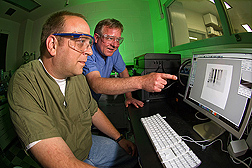Back to the Past With New TSE Testing
|
|
Transmissible spongiform encephalopathies (TSEs) are rare—but lethal—neurodegenerative disorders that affect a range of mammals, including humans. Bovine spongiform encephalopathy (BSE)—or “mad cow disease”—is one TSE that has had significant economic and public health impact. The TSEs in the United States are found in sheep, goats, elk, and deer.
TSE epidemiology is complicated by the fact that a definitive diagnosis cannot be made until after an animal has died. ARS chemist Eric Nicholson and veterinary medical officer Robert Kunkle have found a way to facilitate postmortem TSE diagnoses—even when tissue samples are in short supply.
Proteins called “prions” are produced in all animals. But the development of abnormal prions is believed to prompt the onset of TSE-related damage to brain tissue. If an animal dies from a TSE infection, both abnormal and healthy prions can be found in its body tissues.
Researchers check tissues for abnormal prions with either Western blotting (WB) or immunohistochemistry (IHC). WB is used for fresh or frozen tissues, and IHC is used to test formalin-fixed tissue that has never been frozen. Sometimes only formalin-fixed tissues are available for testing—a situation the BSE surveillance program faced in 2005, when an entire tissue sample was inadvertently preserved in formalin. In that instance, initial IHC results were not conclusive, but there were no other fresh or frozen tissue samples available for WB testing.
Nicholson and Kunkle, who work at the National Animal Disease Center in Ames, Iowa, wanted to help scientists avoid similar situations in the future. They found a way to extract and identify abnormal prions in formalin-fixed tissue by using a combination of mild detergent, a series of freeze-boil cycles, and enzyme digestion. Initial results indicate that the accuracy of this method begins to decline 2 years after the tissue is first preserved, and is completely lost at the end of 6 years.
“With this technique, we can easily distinguish between tissues from TSE-positive and TSE-negative animals,” Nicholson says. “And it requires only a minimal adaptation of existing Western blotting procedures.”
Nicholson and Kunkle also devised a way to use WB to test for TSE in tissues that had been fixed in formalin and preserved in paraffin. Their results equaled—and at times even exceeded—the effectiveness of WB analysis for tissues that had only been fixed in formalin.
These combined results add to the tools animal scientists can use to study the development and spread of TSEs. Their findings will facilitate WB testing of tissue samples that were originally archived for microscopy examination and should simplify preservation of samples collected in the field.
WB and IHC analyses can also be conducted on the same preserved sample—a breakthrough that could significantly enhance ongoing TSE research in the field and in the lab.—By Ann Perry, Agricultural Research Service Information Staff.
This research is part of Animal Health, an ARS national program (#103) described on the World Wide Web at www.nps.ars.usda.gov.
Eric M. Nicholson and Robert A. Kunkle are with the USDA-ARS National Animal Disease Center, 2300 Dayton Ave., Ames, IA 50010; phone (515) 663-7443 [Nicholson],(515) 663-7190 [Kunkle], fax (515) 663-7458.
"Back to the Past With New TSE Testing" was published in the May/June 2009 issue of Agricultural Research magazine.







